Journal Description
Current Issues in Molecular Biology
Current Issues in Molecular Biology
is an international, scientific, peer-reviewed, open access journal on molecular biology, published monthly online by MDPI (from Volume 43 Issue 1-2021).
- Open Access— free for readers, with article processing charges (APC) paid by authors or their institutions.
- High Visibility: indexed within Scopus, SCIE (Web of Science), PMC, PubMed, Embase, CAPlus / SciFinder, FSTA, AGRIS, and other databases.
- Rapid Publication: manuscripts are peer-reviewed and a first decision is provided to authors approximately 13.5 days after submission; acceptance to publication is undertaken in 2.6 days (median values for papers published in this journal in the second half of 2023).
- Recognition of Reviewers: APC discount vouchers, optional signed peer review, and reviewer names are published annually in the journal.
Impact Factor:
3.1 (2022);
5-Year Impact Factor:
3.3 (2022)
Latest Articles
SARS-CoV-2-Induced Type I Interferon Signaling Dysregulation in Olfactory Networks Implications for Alzheimer’s Disease
Curr. Issues Mol. Biol. 2024, 46(5), 4565-4579; https://doi.org/10.3390/cimb46050277 - 10 May 2024
Abstract
Type I interferon signaling (IFN-I) perturbations are major drivers of COVID-19. Dysregulated IFN-I in the brain, however, has been linked to both reduced cognitive resilience and neurodegenerative diseases such as Alzheimer’s. Previous works from our group have proposed a model where peripheral induction
[...] Read more.
Type I interferon signaling (IFN-I) perturbations are major drivers of COVID-19. Dysregulated IFN-I in the brain, however, has been linked to both reduced cognitive resilience and neurodegenerative diseases such as Alzheimer’s. Previous works from our group have proposed a model where peripheral induction of IFN-I may be relayed to the CNS, even in the absence of fulminant infection. The aim of our study was to identify significantly enriched IFN-I signatures and genes along the transolfactory route, utilizing published datasets of the nasal mucosa and olfactory bulb amygdala transcriptomes of COVID-19 patients. We furthermore sought to identify these IFN-I signature gene networks associated with Alzheimer’s disease pathology and risk. Gene expression data involving the nasal epithelium, olfactory bulb, and amygdala of COVID-19 patients and transcriptomic data from Alzheimer’s disease patients were scrutinized for enriched Type I interferon pathways. Gene set enrichment analyses and gene–Venn approaches were used to determine genes in IFN-I enriched signatures. The Agora web resource was used to identify genes in IFN-I signatures associated with Alzheimer’s disease risk based on its aggregated multi-omic data. For all analyses, false discovery rates (FDR) <0.05 were considered statistically significant. Pathways associated with type I interferon signaling were found in all samples tested. Each type I interferon signature was enriched by IFITM and OAS family genes. A 14-gene signature was associated with COVID-19 CNS and the response to Alzheimer’s disease pathology, whereas nine genes were associated with increased risk for Alzheimer’s disease based on Agora. Our study provides further support to a type I interferon signaling dysregulation along the extended olfactory network as reconstructed herein, ranging from the nasal epithelium and extending to the amygdala. We furthermore identify the 14 genes implicated in this dysregulated pathway with Alzheimer’s disease pathology, among which HLA-C, HLA-B, HLA-A, PSMB8, IFITM3, HLA-E, IFITM1, OAS2, and MX1 as genes with associated conferring increased risk for the latter. Further research into its druggability by IFNb therapeutics may be warranted.
Full article
(This article belongs to the Special Issue Advanced Research in Neuroinflammation)
►
Show Figures
Open AccessReview
Adverse Skeletal Muscle Adaptations in Individuals Born Preterm—A Comprehensive Review
by
Nick L. Dobson, Danielle E. Levitt, Hui Ying Luk and Heather L. Vellers
Curr. Issues Mol. Biol. 2024, 46(5), 4551-4564; https://doi.org/10.3390/cimb46050276 - 10 May 2024
Abstract
Infants born preterm face an increased risk of deleterious effects on lung and brain health that can significantly alter long-term function and quality of life and even lead to death. Moreover, preterm birth is also associated with a heightened risk of diabetes and
[...] Read more.
Infants born preterm face an increased risk of deleterious effects on lung and brain health that can significantly alter long-term function and quality of life and even lead to death. Moreover, preterm birth is also associated with a heightened risk of diabetes and obesity later in life, leading to an increased risk of all-cause mortality in young adults born prematurely. While these preterm-birth-related conditions have been well characterized, less is known about the long-term effects of preterm birth on skeletal muscle health and, specifically, an individual’s skeletal muscle hypertrophic potential later in life. In this review, we discuss how a confluence of potentially interrelated and self-perpetuating elements associated with preterm birth might converge on anabolic and catabolic pathways to ultimately blunt skeletal muscle hypertrophy, identifying critical areas for future research.
Full article
(This article belongs to the Collection Molecular Mechanisms in Human Diseases)
►▼
Show Figures

Figure 1
Open AccessArticle
Serum Levels of Zinc, Albumin, Interleukin-6 and CRP in Patients with Unipolar and Bipolar Depression: Cross Sectional Study
by
Tihana Bagarić, Alma Mihaljević-Peleš, Milena Skočić Hanžek, Maja Živković, Ana Kozmar and Dunja Rogić
Curr. Issues Mol. Biol. 2024, 46(5), 4533-4550; https://doi.org/10.3390/cimb46050275 - 9 May 2024
Abstract
Unipolar (UD) and bipolar depression (BDD) show a high degree of similarity in clinical presentations, which complicates the differential diagnosis of these disorders. The aim of this study was to investigate the serum levels of interleukin 6 (IL-6), C-reactive protein (CRP), albumin (Alb),
[...] Read more.
Unipolar (UD) and bipolar depression (BDD) show a high degree of similarity in clinical presentations, which complicates the differential diagnosis of these disorders. The aim of this study was to investigate the serum levels of interleukin 6 (IL-6), C-reactive protein (CRP), albumin (Alb), and zinc (Zn) in patients with UD, BDD, and healthy controls (HC). A total of 211 samples were collected: 131 patient samples (65 UD and 68 BDD) and 80 HC. The Montgomery–Asberg Depression Rating Scale (MADRS), along with the Hamilton Depression Rating Scale (HAMD-17), were administered to patient groups to evaluate symptoms. A cross-sectional study was performed to analyse the serum levels of IL-6, CRP, albumin, and zinc. The concentration of CRP was determined using the immunoturbidimetry method, zinc using the colorimetric method, and albumin using the colorimetric method with bromocresol green on the Alinity c device. IL-6 cytokine concentration in serum samples was ascertained using a commercial enzyme immunoassay, ELISA. We found no significant differences in serum concentrations of zinc, albumin, CRP, and IL-6 between the groups of patients with unipolar and bipolar depression. There was a significant statistical difference (p < 0.001) between serum levels of all investigated parameters in both groups of depressed patients in comparison with HC. Furthermore, correlations with specific items on HAMD-17; (namely, hypochondrias, work and activities, somatic symptoms-general, and weight loss) and on MADRS (concentration difficulties, lassitude) were observed in both patient groups. These findings confirm the presence of low-grade inflammation in depression, thus adding better insight into the inflammation hypothesis directed to explain the aetiology of depressive disorders. Our results do not indicate potential biomarkers for distinguishing between unipolar and bipolar depression.
Full article
(This article belongs to the Special Issue Molecules at Play in Neurological Diseases 2024)
Open AccessReview
Role of NR5A1 Gene Mutations in Disorders of Sex Development: Molecular and Clinical Features
by
Giovanni Luppino, Malgorzata Wasniewska, Roberto Coco, Giorgia Pepe, Letteria Anna Morabito, Alessandra Li Pomi, Domenico Corica and Tommaso Aversa
Curr. Issues Mol. Biol. 2024, 46(5), 4519-4532; https://doi.org/10.3390/cimb46050274 - 9 May 2024
Abstract
Disorders/differences of sex development (DSDs) are defined as broad, heterogenous groups of congenital conditions characterized by atypical development of genetic, gonadal, or phenotypic sex accompanied by abnormal development of internal and/or external genitalia. NR5A1 gene mutation is one of the principal genetic alterations
[...] Read more.
Disorders/differences of sex development (DSDs) are defined as broad, heterogenous groups of congenital conditions characterized by atypical development of genetic, gonadal, or phenotypic sex accompanied by abnormal development of internal and/or external genitalia. NR5A1 gene mutation is one of the principal genetic alterations implicated in causing DSD. This review outlines the role of NR5A1 gene during the process of gonadal development in humans, provides an overview of the molecular and functional characteristics of NR5A1 gene, and discusses potential clinical phenotypes and additional organ diseases due to NR5A1 mutations. NR5A1 mutations were analyzed in patients with 46,XY DSD and 46,XX DSD both during the neonatal and pubertal periods. Loss of function of the NR5A1 gene causes several different phenotypes, including some associated with disease in additional organs. Clinical phenotypes may vary, even among patients carrying the same NR5A1 variant, indicating that there is no specific genotype–phenotype correlation. Genetic tests are crucial diagnostic tools that should be used early in the diagnostic pathway, as early as the neonatal period, when gonadal dysgenesis is the main manifestation of NR5A1 mutation. NR5A1 gene mutations could be mainly associated with amenorrhea, ovarian failure, hypogonadism, and infertility during puberty. Fertility preservation techniques should be considered as early as possible.
Full article
(This article belongs to the Special Issue Complex Molecular Mechanism of Monogenic Diseases 2.0)
►▼
Show Figures
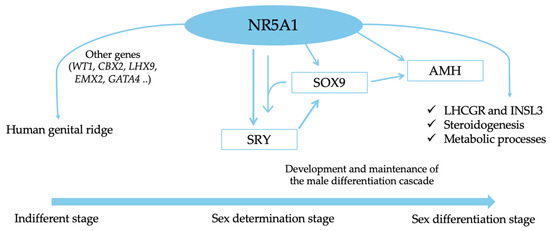
Figure 1
Open AccessArticle
Evaluation of the Therapeutical Effect of Matricaria Chamomilla Extract vs. Galantamine on Animal Model Memory and Behavior Using 18F-FDG PET/MRI
by
Roxana Iacob, Matei Palimariciuc, Tudor Florea, Cosmin Vasilica Pricope, Cristina Mariana Uritu, Bogdan Ionel Tamba, Teodor Marian Ionescu, Cati Raluca Stolniceanu, Wael Jalloul, Romeo Petru Dobrin, Lucian Hritcu, Oana Cioanca, Monica Hancianu, Alexandru Gratian Naum and Cipriana Stefanescu
Curr. Issues Mol. Biol. 2024, 46(5), 4506-4518; https://doi.org/10.3390/cimb46050273 - 9 May 2024
Abstract
The memory-enhancing activity of Matricaria chamomilla hydroalcoholic extract (MCE) is already being investigated by behavioral and biochemical assays in scopolamine-induced amnesia rat models, while the effects of scopolamine (Sco) on cerebral glucose metabolism are examined as well. Nevertheless, the study of the metabolic
[...] Read more.
The memory-enhancing activity of Matricaria chamomilla hydroalcoholic extract (MCE) is already being investigated by behavioral and biochemical assays in scopolamine-induced amnesia rat models, while the effects of scopolamine (Sco) on cerebral glucose metabolism are examined as well. Nevertheless, the study of the metabolic profile determined by an enriched MCE has not been performed before. The present experiments compared metabolic quantification in characteristic cerebral regions and behavioral characteristics for normal, only diseased, diseased, and MCE- vs. Galantamine (Gal)-treated Wistar rats. A memory deficit was induced by four weeks of daily intraperitoneal Sco injection. Starting on the eighth day, the treatment was intraperitoneally administered 30 min after Sco injection for a period of three weeks. The memory assessment comprised three maze tests. Glucose metabolism was quantified after the 18F-FDG PET examination. The right amygdala, piriform, and entorhinal cortex showed the highest differential radiopharmaceutical uptake of the 50 regions analyzed. Rats treated with MCE show metabolic similarity with normal rats, while the Gal-treated group shows features closer to the diseased group. Behavioral assessments evidenced a less anxious status and a better locomotor activity manifested by the MCE-treated group compared to the Gal-treated group. These findings prove evident metabolic ameliorative qualities of MCE over Gal classic treatment, suggesting that the extract could be a potent neuropharmacological agent against amnesia.
Full article
(This article belongs to the Special Issue Metabolism and Molecular Pathology Related Features in Neurological Diseases)
►▼
Show Figures

Figure 1
Open AccessArticle
A Novel Approach Using Reduced Graphene Oxide for the Detection of ALP and RUNX2 Osteogenic Biomarkers
by
Elena Alina Chiticaru and Mariana Ioniță
Curr. Issues Mol. Biol. 2024, 46(5), 4489-4505; https://doi.org/10.3390/cimb46050272 - 8 May 2024
Abstract
In this work, we propose a new technique involving the modification of commercial screen-printed carbon electrodes with electrochemically reduced graphene oxide to serve as the starting point of a future electrochemical biosensor for the detection of two osteogenic biomarkers: alkaline phosphatase (ALP) and
[...] Read more.
In this work, we propose a new technique involving the modification of commercial screen-printed carbon electrodes with electrochemically reduced graphene oxide to serve as the starting point of a future electrochemical biosensor for the detection of two osteogenic biomarkers: alkaline phosphatase (ALP) and Runt-related transcription factor 2 (RUNX2). The electrodes were characterized after each modification by cyclic voltammetry and electrochemical impedance spectroscopy, showing the appropriate electrochemical characteristics for each modification type. The results obtained from scanning electron microscopy, Raman spectroscopy, X-ray photoelectron spectroscopy, and contact angle measurements are well correlated with each other, demonstrating the successful modification of the electrodes with graphene oxide and its subsequent reduction. The bioreceptors were immobilized on the electrodes by physical adsorption, which was confirmed by electrochemical methods, structural characterization, and contact angle measurements. Finally, the functionalized electrodes were incubated with the specific target analytes and the detection relied on monitoring the electrochemical changes occurring after the hybridization process. Our results indicated that the pilot platform has the ability to detect the two biomarkers up to 1 nM, with increased sensitivity observed for RUNX2, suggesting that after further optimizations, it has a high potential to be employed as a future biosensor.
Full article
(This article belongs to the Special Issue Molecular Imaging of Cells and Tissues)
Open AccessReview
Bridging the Gap: Harnessing Plant Bioactive Molecules to Target Gut Microbiome Dysfunctions in Amyotrophic Lateral Sclerosis
by
Mirela Pribac, Anca Motataianu, Sebastian Andone, Elena Mardale and Sebastian Nemeth
Curr. Issues Mol. Biol. 2024, 46(5), 4471-4488; https://doi.org/10.3390/cimb46050271 - 8 May 2024
Abstract
The correlation between neurodegenerative diseases and the gut microbiome is increasingly evident, with amyotrophic lateral sclerosis (ALS) being particularly notable for its severity and lack of therapeutic options. The gut microbiota, implicated in the pathogenesis and development of ALS, plays a crucial role
[...] Read more.
The correlation between neurodegenerative diseases and the gut microbiome is increasingly evident, with amyotrophic lateral sclerosis (ALS) being particularly notable for its severity and lack of therapeutic options. The gut microbiota, implicated in the pathogenesis and development of ALS, plays a crucial role in the disease. Bioactive plant molecules, specifically volatile compounds in essential oils, offer a promising therapeutic avenue due to their anti-inflammatory properties and gut-modulating effects. Our narrative review aimed to identify microbiota-associated bacteria in ALS and analyze the benefits of administering bioactive plant molecules as much-needed therapeutic options in the management of this disease. A comprehensive search of PubMed database articles published before December 2023, encompassing research on cell, human, and animal ALS models, was conducted. After selecting, analyzing, and discussing key articles, bacteria linked to ALS pathogenesis and physiopathology were identified. Notably, positively highlighted bacteria included Akkermansia muciniphila (Verrucomicrobia phylum), Faecalibacterium prausnitzii, and Butyrivibrio spp. (Firmicutes phylum). Conversely, members of the Escherichia coli spp. (Proteobacteria phylum) and Ruminococcus spp. (Firmicutes phylum) stood out negatively in respect to ALS development. These bacteria were associated with molecular changes linked to ALS pathogenesis and evolution. Bioactive plant molecules can be directly associated with improvements in the microbiome, due to their role in reducing inflammation and oxidative stress, emerging as one of the most promising natural agents for enriching present-day ALS treatments.
Full article
(This article belongs to the Special Issue Aging and Oxidative Stress in Nervous System)
►▼
Show Figures

Figure 1
Open AccessArticle
Black Chokeberry (Aronia melanocarpa) Juice Supplementation Improves Oxidative Stress and Aging Markers in Testis of Aged Rats
by
Elena Daskalova, Mina Pencheva and Petko Denev
Curr. Issues Mol. Biol. 2024, 46(5), 4452-4470; https://doi.org/10.3390/cimb46050270 - 8 May 2024
Abstract
Spermatogenesis is a process that continues until the end of an individual’s life, although with reduced activity with advancing age. Inflammation, oxidation, and apoptosis are events considered as predictors of pathogenesis and the development of age-related diseases observed in aged testes. The use
[...] Read more.
Spermatogenesis is a process that continues until the end of an individual’s life, although with reduced activity with advancing age. Inflammation, oxidation, and apoptosis are events considered as predictors of pathogenesis and the development of age-related diseases observed in aged testes. The use of natural compounds with antioxidant and anti-inflammatory properties has a beneficial effect on the inflammatory and oxidative status of the aged testis. The aim of this study was to determine the effect of supplementation with antioxidant-rich black chokeberry (Aronia melanocarpa) juice on several markers of oxidative stress and aging in rat testis. In total, 24 male Wistar rats were divided into three experimental groups: young controls aged 2 months, old controls aged 27 months, and 27-month-old rats supplemented with black chokeberry juice at a dose of 10 mL/kg for 3 months. A. melanocarpa juice supplementation led to reduced oxidative stress, manifested by increased immunoexpression of nNOS, eNOS, and MAS1 in the seminiferous tubules and in the Leydig cells. The morphometrically determined tubule structure data showed no significant differences between the three groups. However, the intensity of the immunoreaction for TRK-C and NT3 in Leydig cells was demonstrably higher in the supplemented old animals compared with the old controls. There was a significantly higher number of blood vessels around the seminiferous tubules in the supplemented animals compared to the old controls. These data indicate that supplementation with A. melanocarpa juice slows down aging processes in the testis and preserves the functional activity of Leydig cells.
Full article
(This article belongs to the Special Issue Molecular Research in Bioactivity of Natural Products)
Open AccessArticle
SCN1A—Characterization of the Gene’s Variants in the Polish Cohort of Patients with Dravet Syndrome: One Center Experience
by
Elżbieta Stawicka, Anita Zielińska, Paulina Górka-Skoczylas, Karolina Kanabus, Renata Tataj, Tomasz Mazurczak and Dorota Hoffman-Zacharska
Curr. Issues Mol. Biol. 2024, 46(5), 4437-4451; https://doi.org/10.3390/cimb46050269 - 7 May 2024
Abstract
The aim of this study was to characterize the genotype and phenotype heterogeneity of patients with SCN1A gene mutations in the Polish population, fulfilling the criteria for the diagnosis of Dravet syndrome (DRVT). Particularly important was the analysis of the clinical course, the
[...] Read more.
The aim of this study was to characterize the genotype and phenotype heterogeneity of patients with SCN1A gene mutations in the Polish population, fulfilling the criteria for the diagnosis of Dravet syndrome (DRVT). Particularly important was the analysis of the clinical course, the type of epileptic seizures and the co-occurrence of additional features such as intellectual disability, autism or neurological symptoms such as ataxia or gait disturbances. Based on their results and the available literature, the authors discuss potential predictors for DRVT. Identifying these early symptoms has important clinical significance, affecting the course and disease prognosis. 50 patients of the Pediatric Neurology Clinic of the Institute of Mother and Child in Warsaw clinically diagnosed with DRVT and carriers of SCN1A pathogenic variants were included. Clinical data were retrospectively collected from caregivers and available medical records. Patients in the study group did not differ significantly in parameters such as type of first seizure and typical epileptic seizures from those described in other studies. The age of onset of the first epileptic seizure was 2–9 months. The co-occurrence of intellectual disability was confirmed in 71% of patients and autism in 18%. The study did not show a correlation between genotype and phenotype, considering the severity of the disease course, clinical symptoms, response to treatment, the presence of intellectual disability, autism symptoms or ataxia. From the clinical course, a significant problem was the differentiation between complex febrile convulsions and symptoms of DRVT. The authors suggest that parameters such as the age of the first seizure, less than one year of age, the onset of a seizure up to 72 h after vaccination and the presence of more than two features of complex febrile seizures are more typical of DRVT, which should translate into adequate diagnostic and clinical management. The substantial decrease in the age of genetic verification of the diagnosis, as well as the decline in the use of sodium channel inhibitors, underscores the growing attention of pediatric neurologists in Poland to the diagnosis of DRVT.
Full article
(This article belongs to the Section Molecular Medicine)
►▼
Show Figures
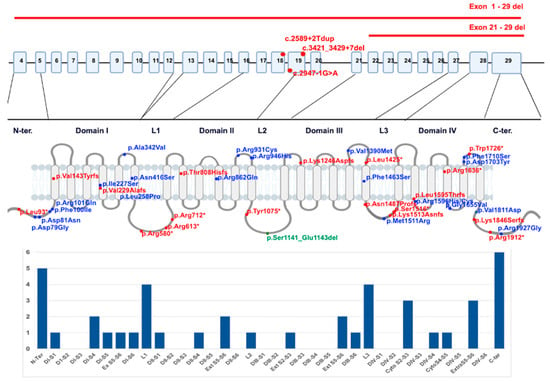
Figure 1
Open AccessArticle
An Accurate Representation of the Number of bZIP Transcription Factors in the Triticum aestivum (Wheat) Genome and the Regulation of Functional Genes during Salt Stress
by
Xin Liu, Selvakumar Sukumaran, Esteri Viitanen, Nupur Naik, Sameer Hassan and Henrik Aronsson
Curr. Issues Mol. Biol. 2024, 46(5), 4417-4436; https://doi.org/10.3390/cimb46050268 - 7 May 2024
Abstract
Climate change is dramatically increasing the overall area of saline soils around the world, which is increasing by approximately two million hectares each year. Soil salinity decreases crop yields and, thereby, makes farming less profitable, potentially causing increased poverty and hunger in many
[...] Read more.
Climate change is dramatically increasing the overall area of saline soils around the world, which is increasing by approximately two million hectares each year. Soil salinity decreases crop yields and, thereby, makes farming less profitable, potentially causing increased poverty and hunger in many areas. A solution to this problem is increasing the salt tolerance of crop plants. Transcription factors (TFs) within crop plants represent a key to understanding salt tolerance, as these proteins play important roles in the regulation of functional genes linked to salt stress. The basic leucine zipper (bZIP) TF has a well-documented role in the regulation of salt tolerance. To better understand how bZIP TFs are linked to salt tolerance, we performed a genome-wide analysis in wheat using the Chinese spring wheat genome, which has been assembled by the International Wheat Genome Sequencing Consortium. We identified 89 additional bZIP gene sequences, which brings the total of bZIP gene sequences in wheat to 237. The majority of these 237 sequences included a single bZIP protein domain; however, different combinations of five other domains also exist. The bZIP proteins are divided into ten subfamily groups. Using an in silico analysis, we identified five bZIP genes (ABF2, ABF4, ABI5, EMBP1, and VIP1) that were involved in regulating salt stress. By scrutinizing the binding properties to the 2000 bp upstream region, we identified putative functional genes under the regulation of these TFs. Expression analyses of plant tissue that had been treated with or without 100 mM NaCl revealed variable patterns between the TFs and functional genes. For example, an increased expression of ABF4 was correlated with an increased expression of the corresponding functional genes in both root and shoot tissues, whereas VIP1 downregulation in root tissues strongly decreased the expression of two functional genes. Identifying strategies to sustain the expression of the functional genes described in this study could enhance wheat’s salt tolerance.
Full article
(This article belongs to the Special Issue Advanced Research in Wheat Genome and Breeding)
►▼
Show Figures
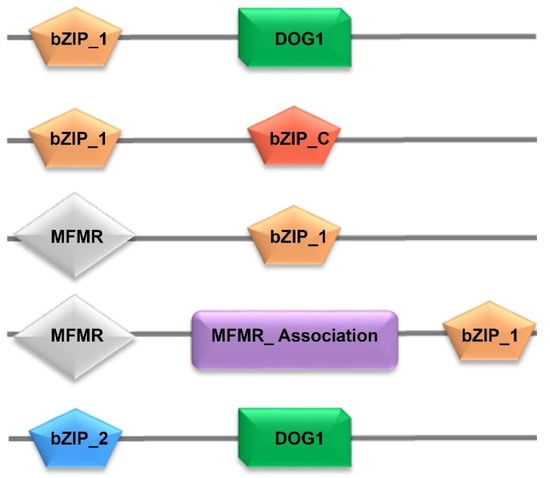
Figure 1
Open AccessArticle
Algal Oil Mitigates Sodium Taurocholate-Induced Pancreatitis by Alleviating Calcium Overload, Oxidative Stress, and NF-κB Activation in Pancreatic Acinar Cells
by
Yi Fang, Sung-Yen Lin, Chung-Hwan Chen and Hui-Chen Lo
Curr. Issues Mol. Biol. 2024, 46(5), 4403-4416; https://doi.org/10.3390/cimb46050267 - 7 May 2024
Abstract
Acute pancreatitis (AP) is characterized by elevated intracellular Ca2+ concentrations, mitochondrial dysfunction, and oxidative stress in pancreatic acinar cells. Algal oil (AO) has demonstrated antioxidant and anti-inflammatory properties. This study aims to explore the effects of algal oil on the microenvironment of
[...] Read more.
Acute pancreatitis (AP) is characterized by elevated intracellular Ca2+ concentrations, mitochondrial dysfunction, and oxidative stress in pancreatic acinar cells. Algal oil (AO) has demonstrated antioxidant and anti-inflammatory properties. This study aims to explore the effects of algal oil on the microenvironment of AP. Rat pancreatic acinar AR42J cells were pretreated with AO containing 0, 50, 100, or 150 μM of docosahexaenoic acid (DHA) 2 h prior to AP induction using sodium taurocholate (STC). After 1 h of STC treatment, AR42J cells exhibited a significant increase in intracellular Ca2+ concentration and the production of amylase, lipase, reactive oxygen species, and pro-inflammatory mediators, including tumor necrosis factor-α and interleukin-6. These STC-induced increases were markedly reduced in cells pretreated with AO. In comparison to cells without AO, those treated with a high dose of AO before STC exposure demonstrated a significant increase in mitochondrial membrane potential and a decrease in lipid peroxidation. Furthermore, STC-activated nuclear factor kappa-B (NF-κB) was attenuated in AO-pretreated cells, as evidenced by a significant decrease in activated NF-κB. In conclusion, AO may prevent damage to pancreatic acinar cells by alleviating intracellular Ca2+ overload, mitigating mitochondrial dysfunction, reducing oxidative stress, and attenuating NF-κB-targeted inflammation.
Full article
(This article belongs to the Special Issue Molecular Research on Free Radicals and Oxidative Stress)
►▼
Show Figures

Figure 1
Open AccessReview
Modulation of Oxidative Stress and Neuroinflammation by Cannabidiol (CBD): Promising Targets for the Treatment of Alzheimer’s Disease
by
Jordan P. Hickey, Andrila E. Collins, Mackayla L. Nelson, Helen Chen and Bettina E. Kalisch
Curr. Issues Mol. Biol. 2024, 46(5), 4379-4402; https://doi.org/10.3390/cimb46050266 - 6 May 2024
Abstract
Alzheimer’s disease (AD) is a progressive neurodegenerative disease and the most common form of dementia globally. Although the direct cause of AD remains under debate, neuroinflammation and oxidative stress are critical components in its pathogenesis and progression. As a result, compounds like cannabidiol
[...] Read more.
Alzheimer’s disease (AD) is a progressive neurodegenerative disease and the most common form of dementia globally. Although the direct cause of AD remains under debate, neuroinflammation and oxidative stress are critical components in its pathogenesis and progression. As a result, compounds like cannabidiol (CBD) are being increasingly investigated for their ability to provide antioxidant and anti-inflammatory neuroprotection. CBD is the primary non-psychotropic phytocannabinoid derived from Cannabis sativa. It has been found to provide beneficial outcomes in a variety of medical conditions and is gaining increasing attention for its potential therapeutic application in AD. CBD is not psychoactive and its lipophilic nature allows its rapid distribution throughout the body, including across the blood–brain barrier (BBB). CBD also possesses anti-inflammatory, antioxidant, and neuroprotective properties, making it a viable candidate for AD treatment. This review outlines CBD’s mechanism of action, the role of oxidative stress and neuroinflammation in AD, and the effectiveness and limitations of CBD in preclinical models of AD.
Full article
(This article belongs to the Special Issue Advanced Research in Neuroinflammation)
►▼
Show Figures

Figure 1
Open AccessReview
Exploring Maternal Diet-Epigenetic-Gut Microbiome Crosstalk as an Intervention Strategy to Counter Early Obesity Programming
by
Maria Felicia Faienza, Flavia Urbano, Federico Anaclerio, Luigi Antonio Moscogiuri, Fani Konstantinidou, Liborio Stuppia and Valentina Gatta
Curr. Issues Mol. Biol. 2024, 46(5), 4358-4378; https://doi.org/10.3390/cimb46050265 - 6 May 2024
Abstract
Alterations in a mother’s metabolism and endocrine system, due to unbalanced nutrition, may increase the risk of both metabolic and non-metabolic disorders in the offspring’s childhood and adulthood. The risk of obesity in the offspring can be determined by the interplay between maternal
[...] Read more.
Alterations in a mother’s metabolism and endocrine system, due to unbalanced nutrition, may increase the risk of both metabolic and non-metabolic disorders in the offspring’s childhood and adulthood. The risk of obesity in the offspring can be determined by the interplay between maternal nutrition and lifestyle, intrauterine environment, epigenetic modifications, and early postnatal factors. Several studies have indicated that the fetal bowel begins to colonize before birth and that, during birth and nursing, the gut microbiota continues to change. The mother’s gut microbiota is primarily transferred to the fetus through maternal nutrition and the environment. In this way, it is able to impact the establishment of the early fetal and neonatal microbiome, resulting in epigenetic signatures that can possibly predispose the offspring to the development of obesity in later life. However, antioxidants and exercise in the mother have been shown to improve the offspring’s metabolism, with improvements in leptin, triglycerides, adiponectin, and insulin resistance, as well as in the fetal birth weight through epigenetic mechanisms. Therefore, in this extensive literature review, we aimed to investigate the relationship between maternal diet, epigenetics, and gut microbiota in order to expand on current knowledge and identify novel potential preventative strategies for lowering the risk of obesity in children and adults.
Full article
(This article belongs to the Section Molecular Medicine)
►▼
Show Figures

Figure 1
Open AccessArticle
Effect of the 35 nm and 70 nm Size Exclusion Chromatography (SEC) Column and Plasma Storage Time on Separated Extracellular Vesicles
by
Bernadett György, Krisztina Pálóczi, Mirjam Balbisi, Lilla Turiák, László Drahos, Tamás Visnovitz, Erika Koltai and Zsolt Radák
Curr. Issues Mol. Biol. 2024, 46(5), 4337-4357; https://doi.org/10.3390/cimb46050264 - 6 May 2024
Abstract
The technical difficulty of separating extracellular vesicles (EVs) from plasma proteins in human blood presents a significant hurdle in EV research, particularly during nano ultra-high-performance liquid chromatography–tandem mass spectrometric (UHPLC-MS/MS) analysis, where detecting “vesicular” proteins among abundant plasma proteins is challenging. Standardisation is
[...] Read more.
The technical difficulty of separating extracellular vesicles (EVs) from plasma proteins in human blood presents a significant hurdle in EV research, particularly during nano ultra-high-performance liquid chromatography–tandem mass spectrometric (UHPLC-MS/MS) analysis, where detecting “vesicular” proteins among abundant plasma proteins is challenging. Standardisation is a pressing issue in EV research, prompting collaborative global efforts to address it. While the MISEV guidelines offer valuable recommendations, unanswered questions remain, particularly regarding sample storage. We compared size exclusion chromatography (SEC) columns with pore sizes of 35 nm and 70 nm to identify fractions with minimal contaminating proteins and the highest concentration of small EVs (sEVs). Following column selection, we explored potential differences in the quality and quantity of sEVs isolated from platelet-free plasma (PFP) after long-term storage at −80 °C (>2.5 years) compared to freshly drawn blood. Our methodologically rigorous study indicates that prolonged storage, under correct storage and processing conditions, does not compromise sEV quality. Both columns effectively isolated vesicles, with the 70 nm column exhibiting a higher abundance of “vesicular” proteins. We propose a relatively rapid and moderately efficient protocol for obtaining a comparatively pure sEV fraction from plasma, facilitating sEV processing in clinical trials.
Full article
(This article belongs to the Section Biochemistry, Molecular and Cellular Biology)
►▼
Show Figures

Figure 1
Open AccessArticle
Expression of G2019S LRRK2 in Rat Primary Astrocytes Mediates Neurotoxicity and Alters the Dopamine Synthesis Pathway in N27 Cells via Astrocytic Proinflammatory Cytokines and Neurotrophic Factors
by
Dong Hwan Ho, Hyejung Kim, Daleum Nam, Mi Kyoung Seo, Sung Woo Park and Ilhong Son
Curr. Issues Mol. Biol. 2024, 46(5), 4324-4336; https://doi.org/10.3390/cimb46050263 - 6 May 2024
Abstract
Astrocytes in the brain contribute to various essential functions, including maintenance of the neuronal framework, survival, communication, metabolic processes, and neurotransmitter levels. Leucine-rich repeat kinase 2 (LRRK2) is associated with the pathogenesis of Parkinson’s disease (PD). LRRK2 is expressed in neurons, microglia, and
[...] Read more.
Astrocytes in the brain contribute to various essential functions, including maintenance of the neuronal framework, survival, communication, metabolic processes, and neurotransmitter levels. Leucine-rich repeat kinase 2 (LRRK2) is associated with the pathogenesis of Parkinson’s disease (PD). LRRK2 is expressed in neurons, microglia, and astrocytes and plays diverse roles in these cell types. We aimed to determine the effects of mutant human G2019S-LRRK2 (GS-hLRRK2) in rat primary astrocytes (rASTROs). Transfection with GS-hLRRK2 significantly decreased cell viability compared to transfection with the vector and wild-type human LRRK2 (WT-hLRRK2). GS-hLRRK2 expression significantly reduced the levels of nerve growth factor and increased the levels of proinflammatory cytokines (interleukin-1β and tumor necrosis factor α) compared to the vector and WT-hLRRK2 expression. Furthermore, GS-hLRRK2 expression in rASTROs promoted astrogliosis, which was characterized by increased expression of glial fibrillary acidic protein and vimentin. Treatment with the conditioned medium of G2019S LRRK2-expressing rASTROs decreased N27 cell viability compared to treatment with that of WT-hLRRK2-expressing rASTROs. Consequently, the regulation of the dopamine synthesis pathway was affected in N27 cells, thereby leading to altered levels of tyrosine hydroxylase, dopamine transporter, Nurr1, and dopamine release. Overall, the G2019S LRRK2 mutation disrupted astrocyte function, thereby aggravating PD progression.
Full article
(This article belongs to the Special Issue Advanced Research in Neuroinflammation)
►▼
Show Figures
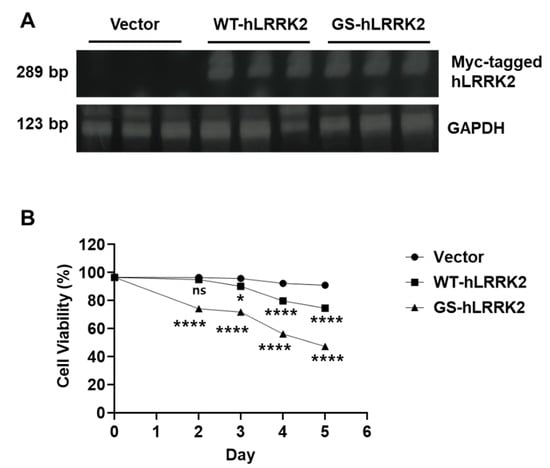
Figure 1
Open AccessArticle
Assessing Chitinases and Neurofilament Light Chain as Biomarkers for Adult-Onset Leukodystrophies
by
Paulo de Lima Serrano, Thaiane de Paulo Varollo Rodrigues, Leslyê Donato Pinto, Indiara Correia Pereira, Igor Braga Farias, Renan Brandão Rambaldi Cavalheiro, Patrícia Marques Mendes, Kaliny Oliveira Peixoto, João Paulo Barile, Daniel Delgado Seneor, Eduardo Gleitzmann Correa Silva, Acary Souza Bulle Oliveira, Wladimir Bocca Vieira de Rezende Pinto and Paulo Sgobbi
Curr. Issues Mol. Biol. 2024, 46(5), 4309-4323; https://doi.org/10.3390/cimb46050262 - 5 May 2024
Abstract
Leukodystrophies represent a large and complex group of inherited disorders affecting the white matter of the central nervous system. Adult-onset leukoencephalopathy with axonal spheroids and pigmented glia (ALSP) is a rare leukodystrophy which still needs the proper identification of diagnostic, prognostic, and monitoring
[...] Read more.
Leukodystrophies represent a large and complex group of inherited disorders affecting the white matter of the central nervous system. Adult-onset leukoencephalopathy with axonal spheroids and pigmented glia (ALSP) is a rare leukodystrophy which still needs the proper identification of diagnostic, prognostic, and monitoring biomarkers. The aim of this study was to determine the diagnostic and prognostic value of chitinases and neurofilament light chain as biomarkers for ALSP. A cross-sectional study was performed to analyze cerebrospinal fluid levels of chitinases (chitotriosidase and chitinase 3-like 2) and neurofilament light chain in five different groups: (i) normal health individuals; (ii) patients with definitive diagnosis of ALSP and genetic confirmation; (iii) asymptomatic patients with CSF1R variants; (iv) patients with other adult-onset leukodystrophies; and (v) patients with amyotrophic lateral sclerosis (external control group). Chitinase levels showed a statistical correlation with clinical assessment parameters in ALSP patients. Chitinase levels were also distinct between ALSP and the other leukodystrophies. Significant differences were noted in the levels of chitinases and neurofilament light chain comparing symptomatic (ALSP) and asymptomatic individuals with CSF1R variants. This study is the first to establish chitinases as a potential biomarker for ALSP and confirms neurofilament light chain as a good biomarker for primary microgliopathies.
Full article
(This article belongs to the Section Molecular Medicine)
►▼
Show Figures

Figure 1
Open AccessReview
Insights into the Activation of Unfolded Protein Response Mechanism during Coronavirus Infection
by
Panagiotis Keramidas, Maria Pitou, Eleni Papachristou and Theodora Choli-Papadopoulou
Curr. Issues Mol. Biol. 2024, 46(5), 4286-4308; https://doi.org/10.3390/cimb46050261 - 5 May 2024
Abstract
Coronaviruses represent a significant class of viruses that affect both animals and humans. Their replication cycle is strongly associated with the endoplasmic reticulum (ER), which, upon virus invasion, triggers ER stress responses. The activation of the unfolded protein response (UPR) within infected cells
[...] Read more.
Coronaviruses represent a significant class of viruses that affect both animals and humans. Their replication cycle is strongly associated with the endoplasmic reticulum (ER), which, upon virus invasion, triggers ER stress responses. The activation of the unfolded protein response (UPR) within infected cells is performed from three transmembrane receptors, IRE1, PERK, and ATF6, and results in a reduction in protein production, a boost in the ER’s ability to fold proteins properly, and the initiation of ER-associated degradation (ERAD) to remove misfolded or unfolded proteins. However, in cases of prolonged and severe ER stress, the UPR can also instigate apoptotic cell death and inflammation. Herein, we discuss the ER-triggered host responses after coronavirus infection, as well as the pharmaceutical targeting of the UPR as a potential antiviral strategy.
Full article
(This article belongs to the Special Issue Research on Virus-Induced Cellular and Molecular Responses)
►▼
Show Figures
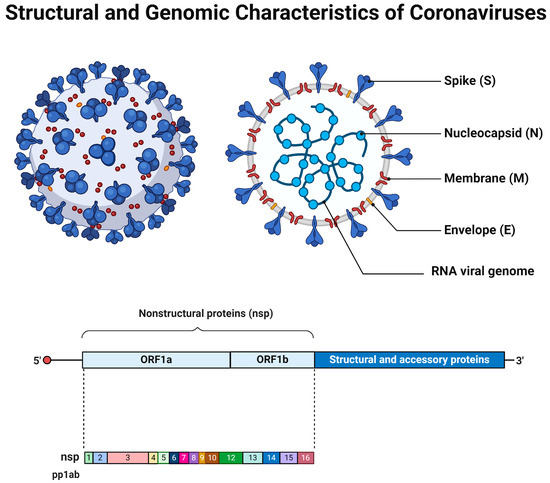
Figure 1
Open AccessReview
The Role of Galectins in Asthma Pathophysiology: A Comprehensive Review
by
Andrea Portacci, Ilaria Iorillo, Leonardo Maselli, Monica Amendolara, Vitaliano Nicola Quaranta, Silvano Dragonieri and Giovanna Elisiana Carpagnano
Curr. Issues Mol. Biol. 2024, 46(5), 4271-4285; https://doi.org/10.3390/cimb46050260 - 3 May 2024
Abstract
Galectins are a group of β-galactoside-binding proteins with several roles in immune response, cellular adhesion, and inflammation development. Current evidence suggest that these proteins could play a crucial role in many respiratory diseases such as pulmonary fibrosis, lung cancer, and respiratory infections. From
[...] Read more.
Galectins are a group of β-galactoside-binding proteins with several roles in immune response, cellular adhesion, and inflammation development. Current evidence suggest that these proteins could play a crucial role in many respiratory diseases such as pulmonary fibrosis, lung cancer, and respiratory infections. From this standpoint, an increasing body of evidence have recognized galectins as potential biomarkers involved in several aspects of asthma pathophysiology. Among them, galectin-3 (Gal-3), galectin-9 (Gal-9), and galectin-10 (Gal-10) are the most extensively studied in human and animal asthma models. These galectins can affect T helper 2 (Th2) and non-Th2 inflammation, mucus production, airway responsiveness, and bronchial remodeling. Nevertheless, while higher Gal-3 and Gal-9 concentrations are associated with a stronger degree of Th-2 phlogosis, Gal-10, which forms Charcot–Leyden Crystals (CLCs), correlates with sputum eosinophilic count, interleukin-5 (IL-5) production, and immunoglobulin E (IgE) secretion. Finally, several galectins have shown potential in clinical response monitoring after inhaled corticosteroids (ICS) and biologic therapies, confirming their potential role as reliable biomarkers in patients with asthma.
Full article
(This article belongs to the Section Molecular Medicine)
►▼
Show Figures

Figure 1
Open AccessArticle
Membrane Association of the Short Transglutaminase Type 2 Splice Variant (TG2-S) Modulates Cisplatin Resistance in a Human Hepatocellular Carcinoma (HepG2) Cell Line
by
Dipak D. Meshram, Cristina Fanutti, Claire V. S. Pike and Peter J. Coussons
Curr. Issues Mol. Biol. 2024, 46(5), 4251-4270; https://doi.org/10.3390/cimb46050259 - 2 May 2024
Abstract
Hepatocellular carcinoma (HCC) is a heterogeneous malignancy with complex carcinogenesis. Although there has been significant progress in the treatment of HCC over the past decades, drug resistance to chemotherapy remains a major obstacle in its successful management. In this study, we were able
[...] Read more.
Hepatocellular carcinoma (HCC) is a heterogeneous malignancy with complex carcinogenesis. Although there has been significant progress in the treatment of HCC over the past decades, drug resistance to chemotherapy remains a major obstacle in its successful management. In this study, we were able to reduce chemoresistance in cisplatin-resistant HepG2 cells by either silencing the expression of transglutaminase type 2 (TG2) using siRNA or by the pre-treatment of cells with the TG2 enzyme inhibitor cystamine. Further analysis revealed that, whereas the full-length TG2 isoform (TG2-L) was almost completely cytoplasmic in its distribution, the majority of the short TG2 isoform (TG2-S) was membrane-associated in both parental and chemoresistant HepG2 cells. Following the induction of cisplatin toxicity in non-chemoresistant parental cells, TG2-S, together with cisplatin, quickly relocated to the cytosolic fraction. Conversely, no cytosolic relocalisation of TG2-S or nuclear accumulation cisplatin was observed, following the identical treatment of chemoresistant cells, where TG2-S remained predominantly membrane-associated. This suggests that the deficient subcellular relocalisation of TG2-S from membranous structures into the cytoplasm may limit the apoptic response to cisplatin toxicity in chemoresistant cells. Structural analysis of TG2 revealed the presence of binding motifs for interaction of TG2-S with the membrane scaffold protein LC3/LC3 homologue that could contribute to a novel mechanism of chemotherapeutic resistance in HepG2 cells
Full article
(This article belongs to the Section Biochemistry, Molecular and Cellular Biology)
►▼
Show Figures
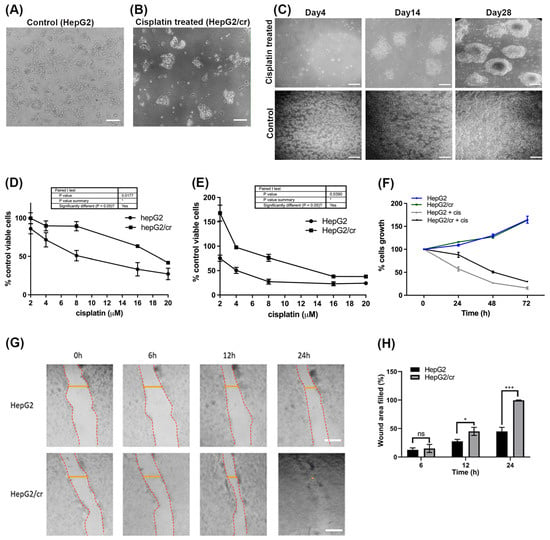
Figure 1
Open AccessReview
Salivary Diagnosis of Dental Caries: A Systematic Review
by
Rita Antonelli, Valentina Massei, Elena Ferrari, Mariana Gallo, Thelma A. Pertinhez, Paolo Vescovi, Silvia Pizzi and Marco Meleti
Curr. Issues Mol. Biol. 2024, 46(5), 4234-4250; https://doi.org/10.3390/cimb46050258 - 2 May 2024
Abstract
The activity of dental caries, combined with its multifactorial etiology, alters salivary molecule composition. The present systematic review was developed to answer the following question: “Are salivary biomarkers reliable for diagnosis of dental caries?”. Following the “Preferred Reporting Item for Systematic Reviews and
[...] Read more.
The activity of dental caries, combined with its multifactorial etiology, alters salivary molecule composition. The present systematic review was developed to answer the following question: “Are salivary biomarkers reliable for diagnosis of dental caries?”. Following the “Preferred Reporting Item for Systematic Reviews and Meta-analysis” (PRISMA) guidelines, the review was conducted using multiple database research (Medline, Web of Science, and Scopus). Studies performed on healthy subjects with and without dental caries and providing detailed information concerning the clinical diagnosis of caries (Decayed, Missing, Filled Teeth-DMFT and International Caries Detection and Assessment System-ICDAS criteria) were included. The quality assessment was performed following a modified version of the Joanna Briggs Institute Prevalence Critical Appraisal Checklist. The protocol was registered in the International Prospective Register of Systematic Reviews (PROSPERO, ID: CRD42022304505). Sixteen papers were included in the review. All studies reported statistically significant differences in the concentration of salivary molecules between subjects with and without caries (p < 0.05). Proteins were the most investigated molecules, in particular alpha-amylase and mucins. Some studies present a risk of bias, such as identifying confounding factors and clearly defining the source population. Nevertheless, the 16 papers were judged to be of moderate to high quality. There is evidence that some salivary compounds studied in this review could play an important diagnostic role for dental caries, such as salivary mucins, glycoproteins (sCD14), interleukins (IL-2RA, 4,-13), urease, carbonic anhydrase VI, and urea.
Full article
(This article belongs to the Section Molecular Medicine)
►▼
Show Figures

Figure 1

Journal Menu
► ▼ Journal MenuJournal Browser
► ▼ Journal Browser-
arrow_forward_ios
Forthcoming issue
arrow_forward_ios Current issue - Volumes not published by MDPI
- Vol. 42 (2021)
- Vol. 41 (2021)
- Vol. 40 (2021)
- Vol. 39 (2020)
- Vol. 38 (2020)
- Vol. 37 (2020)
- Vol. 36 (2020)
- Vol. 35 (2020)
- Vol. 34 (2019)
- Vol. 33 (2019)
- Vol. 32 (2019)
- Vol. 31 (2019)
- Vol. 30 (2019)
- Vol. 29 (2018)
- Vol. 28 (2018)
- Vol. 27 (2018)
- Vol. 26 (2018)
- Vol. 25 (2018)
- Vol. 24 (2017)
- Vol. 23 (2017)
- Vol. 22 (2017)
- Vol. 21 (2017)
- Vol. 20 (2016)
- Vol. 19 (2016)
- Vol. 18 (2016)
- Vol. 17 (2015)
- Vol. 16 (2014)
- Vol. 15 (2013)
- Vol. 14 (2012)
- Vol. 13 (2011)
- Vol. 12 (2010)
- Vol. 11 (2009)
- Vol. 10 (2008)
- Vol. 9 (2007)
- Vol. 8 (2006)
- Vol. 7 (2005)
- Vol. 6 (2004)
- Vol. 5 (2003)
- Vol. 4 (2002)
- Vol. 3 (2001)
- Vol. 2 (2000)
- Vol. 1 (1999)
Highly Accessed Articles
Latest Books
E-Mail Alert
News
Topics
Topic in
Biomedicines, CIMB, Endocrines, IJMS, JMP, Life, Reprod. Med.
Pathogenesis of Pregnancy-Related Complications 2.0
Topic Editors: Ilona Hromadnikova, Katerina KotlabovaDeadline: 31 August 2024
Topic in
BioMed, Biomedicines, CIMB, Foods, Nutrients
Novel Therapeutic Nutrient Molecules, 2nd Volume
Topic Editors: Sathish Kumar Natarajan, Jiujiu Yu, Corrine K Hanson, Melissa ThoeneDeadline: 31 December 2024
Topic in
BioChem, Biomolecules, CIMB, Molecules, Pharmaceutics, Sci. Pharm.
Design, Synthesis and Biological Evaluation of Novel Small Molecules as Multi-target Enzyme Inhibitors
Topic Editors: Davide Moi, Daniele Passarella, Andrea CitarellaDeadline: 31 January 2025
Topic in
CIMB, Molecules, Pharmaceuticals, Pharmaceutics, Sci. Pharm.
Challenges and Opportunities in Drug Delivery Research
Topic Editors: Lenuta Profire, Ioana Mirela VasincuDeadline: 31 March 2025

Conferences
Special Issues
Special Issue in
CIMB
Advanced Research of Ionizing Radiation in Cancers
Guest Editors: Lorenzo Lodola, Onelio Geatti, Carlo AprileDeadline: 31 May 2024
Special Issue in
CIMB
Molecular Research on Female Reproductive Diseases
Guest Editor: Hsien-Ming WuDeadline: 30 June 2024
Special Issue in
CIMB
Molecular Mechanisms and Regulation in Allergy and Immune Diseases, Immunodeficiencies
Guest Editors: Natalia Ukleja-Sokołowska, Kinga LisDeadline: 31 July 2024
Special Issue in
CIMB
Latest Multifactorial Developments on Neuropsychiatric Disorders and Manifestations
Guest Editor: Alin CiobicaDeadline: 31 August 2024
Topical Collections
Topical Collection in
CIMB
Feature Papers Collection in Molecular Microbiology
Collection Editor: Bruce Seal
Topical Collection in
CIMB
Application of Natural and Pseudo Natural Products in Drug Discovery and Development
Collection Editor: Hidayat Hussain
Topical Collection in
CIMB
Feature Papers in Current Issues in Molecular BiologyCollection Editor: Madhav Bhatia







